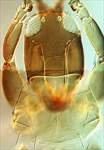Generic diagnosis
Medium sized, macropterous or micropterous Phlaeothripinae. Head longer than wide, vertex with almost no sculpture lines; postocular setae capitate; mouth cone short and rounded; maxillary stylets retracted half way to postocular setae, widely spaced in V-shape, with maxillary bridge. Antennae 8-segmented; segment III with 1 sense-cone, IV with 4 sense cones; segment VIII not constricted at base. Pronotum with almost no sculpture; notopleural sutures complete; with 5 pairs of major setae, but anteromarginals often short. Prosternal basantra, ferna and spinasternum well developed; mesopresternum absent medially; metathoracic sternopleural sutures weak or absent. Fore tarsal tooth present in both sexes but small in female. Fore wing almost parallel sided, without duplicated cilia. Pelta triangular; tergites III‒VI of macropterae and micropterae each with one pair of stout sigmoid wing-retaining setae, II and VII with these setae weaker; tergite IX setae about as long as tube; tube shorter than head. Male tergite IX setae S2 short and stout; sternite VIII with no pore plate.
Nomenclatural data
Plicothrips Bhatti, 1979: 306. Type species Hindsiana apicalis Bagnall 1915, by original designation.
Two species are listed in this genus (ThripsWiki, 2022), but the one from Egypt and Sudan is possibly the same as the type species.
Australian species
Plicothrips apicalis (Bagnall, 1915: 323)
Relationship data
This genus shares most character states with species of Haplothrips. It is distinguished because the abdominal tergites have only one stout pair of sigmoid wing-retaining setae, in both micropterae and macropterae. Moreover, the fore wing is very weakly constricted and lacks duplicated cilia. Populations in India apparently differ in having the notopleural sutures incomplete.
Distribution data
Described from India where it is reported to be common, apicalis has been studied from Thailand, Laos, Taiwan, and Timor Leste. From Australia, a single large sample has been studied from Ashmore Reef (Northern Territory).
Biological data
The species of this genus have usually been reported from Cynodon dactylon [Poaceae].
References
Bhatti JS (1979) Studies in some haplothripine forms. Nouvelle Revue d'Entomologie 9: 305–311.
ThripsWiki (2022) ThripsWiki - providing information on the World's thrips. Available from: http://thrips.info/wiki/ (Accessed 15.iii.2022)



